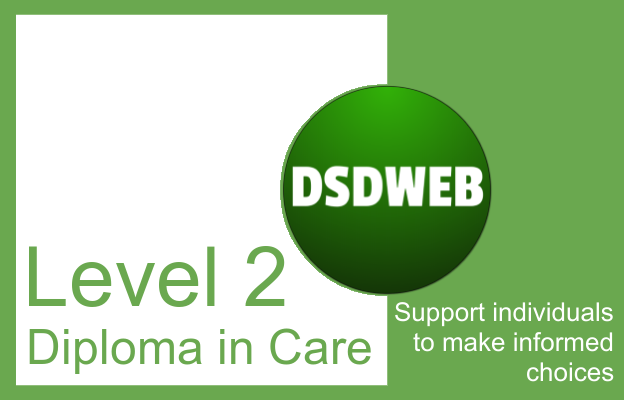This page is designed to answer the following questions:
- 7.3a Describe ways of helping individuals to make informed choices (Care Certificate, Standard 7: Privacy and dignity)
- 7.4a Demonstrate how to support individuals to make informed choices (Care Certificate, Standard 7: Privacy and dignity)
- 7.3b Explain how risk assessment processes can be used to support the right of individuals to make their own decisions (Care Certificate, Standard 7: Privacy and dignity)
- 7.4b Ensure any risk assessment processes are used to support the right of individuals to make their own decisions (Care Certificate, Standard 7: Privacy and dignity)
- 7.5b Explain how to enable individuals to make informed choices about their lives (Care Certificate, Standard 7: Privacy and dignity)
- 5.1 Support an individual to make informed choices (Level 2 Diploma in Care, Implement person-centred approaches in care settings)
- 5.2 Use agreed risk assessment processes to support the right to make choices (Level 2 Diploma in Care, Implement person-centred approaches in care settings)
- 5.1 Support an individual to make informed choices (Level 3 Diploma in Adult Care, Promote person-centred approaches in care settings)
- 5.2 Use own role and authority to support the individual’s right to make choices (Level 3 Diploma in Adult Care, Promote person-centred approaches in care settings)
- 5.3 Manage risk in a way that maintains the individual’s right to make choices (Level 3 Diploma in Adult Care, Promote person-centred approaches in care settings)
NOTE: This page has been quality assured for 2023 as per our Quality Assurance policy.
As part of a person-centred approach, care workers should support individuals to be as independent as possible, encourage them to make their own choices and respect the decisions that they make.
Choices can be relatively small day-to-day decisions, such as:
- what time to go to bed
- what clothes to wear
- whether to stay in or go out
Or larger, more serious decisions that could even be life-changing, such as:
- whether to get married or not
- whether to undergo a surgical procedure or not
- whether to have a sexual relationship or not
Support individuals to make informed choices
To empower an individual to make their own decisions, it is important that you ensure they have access to and understand all the relevant data so that they can make an informed choice.
This could be through yourself or a third party explaining the pros and cons of a decision, educational workshops (such as a sex and relationships course), printed materials such as leaflets and posters or information from research on the Internet.
When providing an individual with information, it is essential that you do not let your own personal views or beliefs bias their decision.
Use risk assessments as a tool
A good way of supporting an individual’s right to choose is by using agreed risk assessment processes.
Risk assessments involve gathering all the relevant information about a choice, assessing the likelihood and severity of the potential negative consequences and weighing that up against the possible positive outcomes to decide if the risk is worth taking.
By performing the risk assessment process with an individual, you can:
- help them gather the relevant data to make an informed choice
- help them to identify the possible risks and rewards
- support them to critically analyse their options
- help them to identify ways to remove or reduce the likelihood or severity of the risks
When you have laid out the information to an individual and there is nothing to suggest that they do not have the capacity to make the decision on their own, you should respect and support whatever choice the individual makes, even if you believe it to be unwise.
You should work with the individual to agree on ways that the risk can be reduced or eliminated. For example, the winter months could present a greater risk to individuals that have a heart condition, so you may agree that they always wrap up warm when going outside and only remain outside for a short amount of time. Or an individual with cognitive impairments (such as dementia) that may cause them to get lost agrees to carry a GPS locator and stick to agreed routes and times. You may also agree with them that they carry identification when they go out.
Risk assessments should be regularly reviewed to ensure that they are still fit for purpose and take into account an individual’s changing needs. For example, the physical or cognitive ability of an individual may change (such as deteriorating eyesight), which would make crossing the road more hazardous. Or external circumstances, like the Covid-19 outbreak, would mean that extra precautions would need to be taken when accessing the community. Risk assessments should always be updated following an accident or incident.
You should keep a written record of the options that were considered and the decisions that were made so that you are able to demonstrate that active participation was used and remind individuals of the choices that they made and the reasons they made them.
Use role and authority to support choice-making
If you are working towards your Level 3 Diploma in Adult Care, you will also need to explain or demonstrate how you can use your role and authority as a senior or lead practitioner to support an individual’s right to make choices.
This could mean being assertive and promoting an individual’s rights by explaining to others why individuals have the right to make their own decisions, supporting individuals to stand up for themselves and challenge decisions about them that are made by others, helping individuals to make official complaints or mentoring colleagues about best practice. In addition, you should always aspire to be a positive role model for others.

